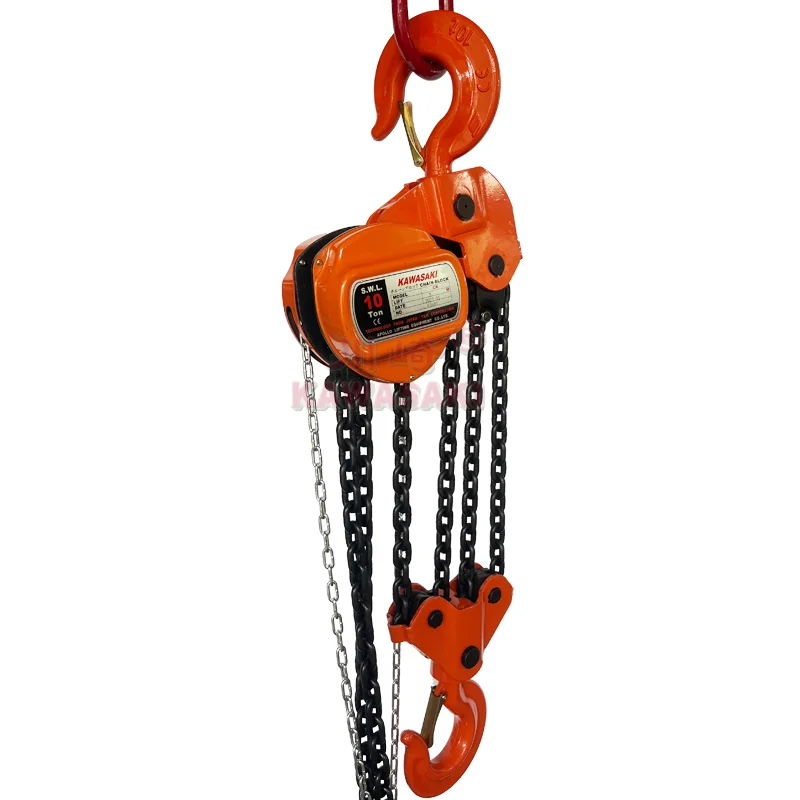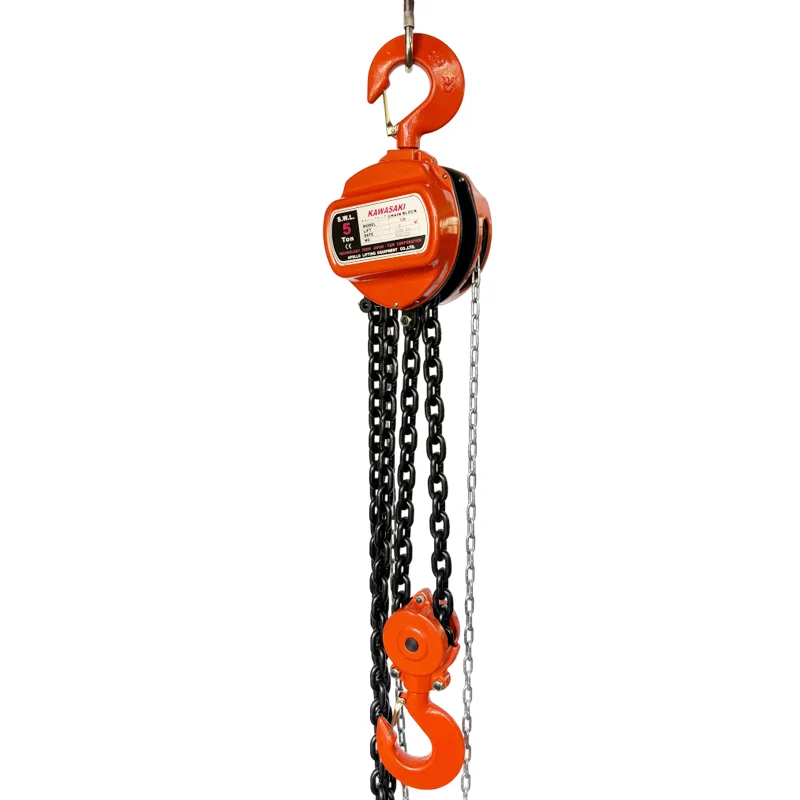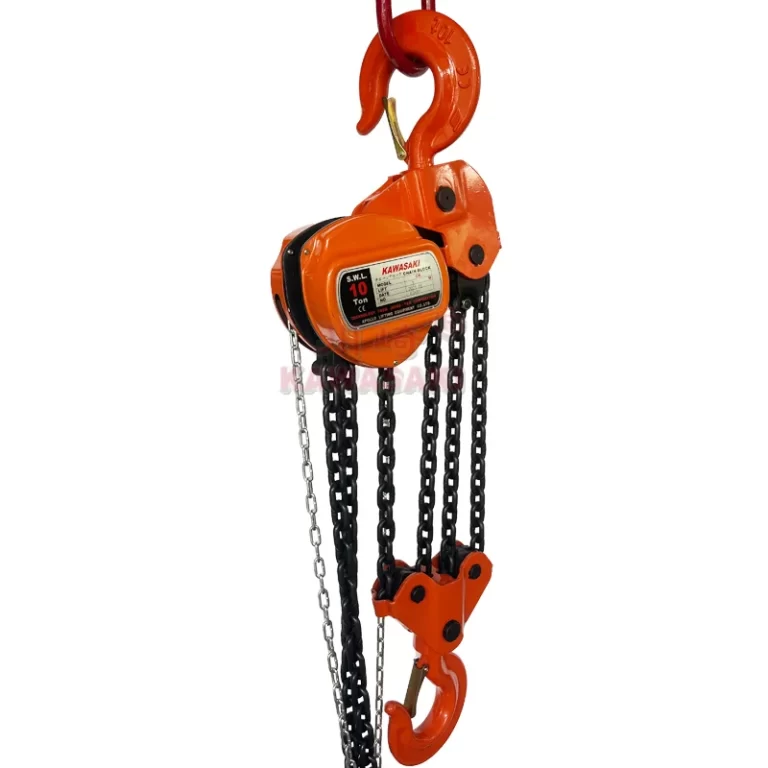Imagine you’re on a busy construction site in Kaohsiung, Taiwan. Steel beams need to go up, the crew’s ready, but your hand chain hoist can’t handle the weight. Too small, and you risk a broken chain. Too big, and you’re hauling extra bulk for no reason. Picking the right size hand chain hoist is about getting the job done safely and quickly. This guide, backed by APOLLO, will help you choose the perfect hoist for tough tasks.

Understanding Hand Chain Hoist Basics
What is a Hand Chain Hoist?
A hand chain hoist is a simple tool for lifting heavy stuff. You pull a chain, and gears inside make the load go up—anywhere from a few hundred pounds to 20 tons. It’s like a strong buddy who doesn’t need a power outlet. APOLLO’s Kawasaki brand has models like the CK 1T for small jobs and the CK 20T for big industrial lifts.
Why Pick a Hand Chain Hoist for Heavy Work?
Hand chain hoists are great when you’re off the grid or need something easy to carry. They’re lighter than electric hoists and work anywhere—think remote farms lifting hay or construction sites with no power. They’re also kind to your wallet. APOLLO’s Kawasaki hoists, with ISO9001 and CE/GS stamps, are built tough for heavy jobs without breaking the bank.

Key Factors for Picking the Right Size
Choose the right hoist by understanding load capacity, lift height, and environment—ensuring safety and efficiency for any task.
Figuring Out Load Capacity
How to Calculate Your Load
Know your load’s weight first. Lifting a 2,000-pound steel plate? Don’t pick a hoist rated exactly at that. Safety comes first. APOLLO follows a 4x safety rule, so a 1-ton (2,000-pound) hoist like the Kawasaki CK 1T works fine. But if the load swings or jerks, go for a 3-ton CK 3T instead. Add a 20% buffer to stay safe.
Common Sizes: 1 Ton to 50 Tons
Hoists come in all sizes. A 1-ton hoist is great for small shops, like lifting car engines. For big factory jobs, like setting up cranes, you might need a 10-ton or 20-ton hoist, like APOLLO’s Kawasaki CK series. I heard about a guy in Singapore who tried a 1-ton hoist on a 3-ton load. The chain didn’t snap, but the gears sounded like a creaky old door. Size up to avoid trouble.
Lift Height and Chain Length
Measuring How High You Need
How far up does your load need to go? Measure from the hook to the top spot, then add a couple of feet for extra chain. For a 15-foot lift onto a scaffold, a 20-foot chain, like on Kawasaki’s CK hoists, does the trick. For tall warehouses or deep wells, you might need a custom length. APOLLO offers strong T80/T100 chains that handle humid spots like Kaohsiung’s docks.
Custom Chain Choices
APOLLO’s Kawasaki hoists let you tweak the chain. Need rust-proof for a shipyard? They’ve got galvanized or blackened options. Setting up a stage? Their 360° operation lets you pull from any angle—great for theater rigging. Custom orders need at least 100 units, but APOLLO’s 5,000-unit monthly output can keep up.
Lifting Speed and Ease
Single-Speed vs. Variable Options
With hand chain hoists, speed depends on how fast you pull. Smaller hoists (1-3 tons) need about 50-70 pounds of pull for a 1-ton load. Bigger ones, like the 20-ton CK, take more muscle but have tough, heat-treated gears for smooth pulls. Need faster lifts? APOLLO’s electric hoists are an option, but they cost more.
Mounting and Power Options
Hook, Trolley, or Fixed Setup
How will you hang the hoist? A hook works for quick jobs. For tasks where you move loads along a beam, a monorail trolley is better. APOLLO’s Kawasaki hoists pair with trolleys for 3-6 inch beams. Double-check your beam size to avoid wobbly setups.
Environment and Toughness
Handling Harsh Conditions
Working near chemicals or gas? You need an explosion-proof hoist like APOLLO’s Kawasaki HBSQ series, made with spark-free copper alloy. For dusty or rainy sites, rust-proof and dust-proof options keep things running. All APOLLO hoists pass strict tests to meet CE/GS standards, so they’re good for global use.
Build Quality and Certifications
APOLLO uses strong alloy steel, with chains rated at 800 MPa breaking strength. Their ISO9001 badge means every hoist is checked for lifting power and stability before shipping. I’ve seen cheap hoists give out under pressure. Stick with certified brands like APOLLO to save headaches.
Budget and Future Plans
Cost vs. Value
A 1-ton hoist might cost $100-$200, while a 20-ton one could hit $1,000. Don’t go too cheap, though. A solid hoist saves on repairs and downtime. APOLLO’s Kawasaki hoists let you customize colors, logos, or packaging to fit your brand, boosting resale value. Their one-year warranty and spare parts service are a nice touch.
Planning for Growth
Think about tomorrow. A 3-ton hoist might work now, but if your business grows, you’ll need more. APOLLO’s Kawasaki range, from 1-ton to 20-ton, gives you room to scale. Their ODM/OEM services let you adjust designs as your needs change.
Safety Features and Best Practices
Must-Have Safety Parts
Every hoist needs overload protection and auto-brakes. APOLLO’s Kawasaki CK series has load-limiting features to stop overloads. Their heat-treated gears and sturdy hooks (like on the CK 10T) add reliability. Always look for a 4x safety factor—APOLLO’s standard.
Checking Before Use
Before lifting, check the chain for wear or rust. Test the brake with a light load, just a few inches up. APOLLO’s video guides (included with purchase) show you how. Skipping checks is like driving with flat tires—not smart.
Avoiding Common Risks
Overloading, chain jams, or bad mounting can cause trouble. Weigh your load, oil the chain, and secure the hoist properly. APOLLO’s sealed gear boxes keep dust out, cutting down on jams in rough spots.
Maintenance and Care for Longevity
Regular Checks and Oiling
Look at your hoist weekly for loose bolts or worn chains. Use light oil on the chain—APOLLO suggests this for their T80/T100 chains. For heavy use, get a pro to inspect it yearly. I saw a client skip maintenance once, and their hoist froze mid-lift. Total mess.
Fixing Common Problems
Chain slipping? Could be too much weight or worn gears. Strange noises? Check for dirt in the gear box. APOLLO’s Kawasaki team can send replacement parts fast to keep you moving.
Storing Your Hoist
Keep your hoist in a dry, covered spot to stop rust. Coil the chain neatly to avoid kinks. APOLLO’s packaging, like wooden boxes, makes storing bulk orders easy.
Conclusion: Making the Right Choice for Safe and Efficient Lifting
Picking the right hand chain hoist size means knowing your load, height, and work environment. Whether it’s a 1-ton hoist for a small shop or a 20-ton giant for big projects, APOLLO’s Kawasaki CK series delivers strength, customization, and safety. With 5,000 units made monthly and global certifications, they’re a solid pick for heavy-duty jobs.
FAQ
Q1. What’s the minimum order for a custom hand chain hoist?
A: APOLLO’s Kawasaki brand needs at least 100 units for custom orders, like special chain finishes or branded boxes. Standard orders have no minimum, and they can supply 5,000 units a month.
Q2. Can I use a hand chain hoist in rain or dust?
A: Sure, but pick one with rust-proof or dust-proof features. APOLLO’s Kawasaki CK series has galvanized or blackened chains, and their HBSQ models are explosion-proof for tough spots.
Q3. How do I know my hoist is safe to use?
A: Check the chain, hooks, and gears before each lift. Make sure it has a 4x safety factor and overload protection, standard on APOLLO’s Kawasaki hoists. Their video guides help with proper checks.

